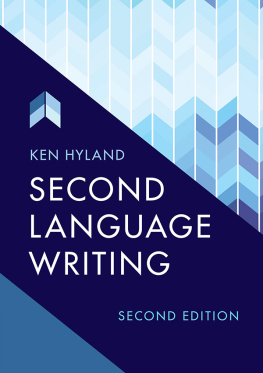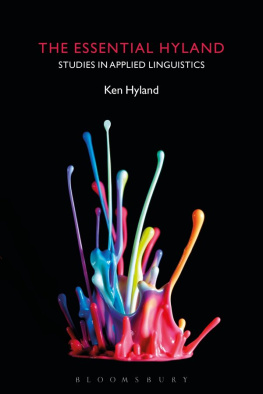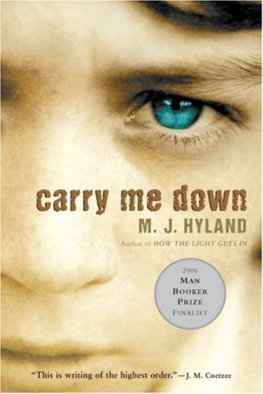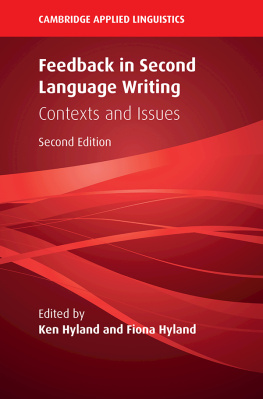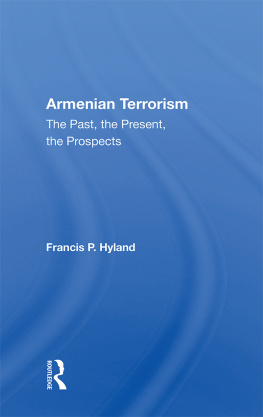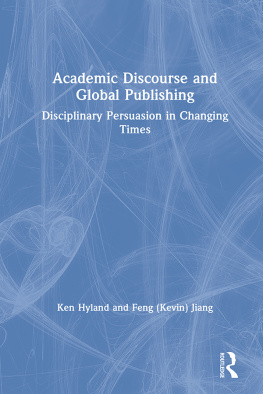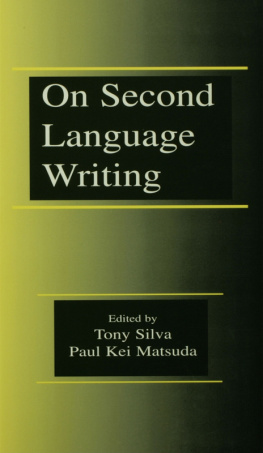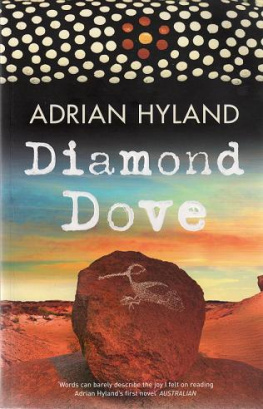Hyland - Second Language Writing
Here you can read online Hyland - Second Language Writing full text of the book (entire story) in english for free. Download pdf and epub, get meaning, cover and reviews about this ebook. year: 2019, publisher: Cambridge University Press, genre: Home and family. Description of the work, (preface) as well as reviews are available. Best literature library LitArk.com created for fans of good reading and offers a wide selection of genres:
Romance novel
Science fiction
Adventure
Detective
Science
History
Home and family
Prose
Art
Politics
Computer
Non-fiction
Religion
Business
Children
Humor
Choose a favorite category and find really read worthwhile books. Enjoy immersion in the world of imagination, feel the emotions of the characters or learn something new for yourself, make an fascinating discovery.
- Book:Second Language Writing
- Author:
- Publisher:Cambridge University Press
- Genre:
- Year:2019
- Rating:3 / 5
- Favourites:Add to favourites
- Your mark:
- 60
- 1
- 2
- 3
- 4
- 5
Second Language Writing: summary, description and annotation
We offer to read an annotation, description, summary or preface (depends on what the author of the book "Second Language Writing" wrote himself). If you haven't found the necessary information about the book — write in the comments, we will try to find it.
Hyland: author's other books
Who wrote Second Language Writing? Find out the surname, the name of the author of the book and a list of all author's works by series.
Second Language Writing — read online for free the complete book (whole text) full work
Below is the text of the book, divided by pages. System saving the place of the last page read, allows you to conveniently read the book "Second Language Writing" online for free, without having to search again every time where you left off. Put a bookmark, and you can go to the page where you finished reading at any time.
Font size:
Interval:
Bookmark:

Second Language Writing
Second Edition
Authoritative and accessible, this book introduces the theory and practice of teaching writing to students of EFL/ESL learners. While assuming no specialist knowledge, Ken Hyland systematically sets out the key issues of course design, lesson planning, texts and materials, tasks, feedback and assessment and how current research can inform classroom practice. This second edition is completely revised to include up-to-date work on automated feedback, plagiarism, social media, Virtual Learning Environments and teacher workload issues. It takes the stance that student writers not only need realistic strategies for drafting and revising, but also a clear understanding of genre to structure their writing experiences according to the expectations of particular communities of readers and the constraints of particular contexts. Review exercises, reflection questions, plentiful examples and a new extensive glossary make the book invaluable to both prospective and practising teachers alike.
Ken Hyland is Professor of Applied Linguistics in Education at the University of East Anglia. His research focuses on writing and academic discourse, having published over 240 articles and 27 books on these topics. He is founding co-editor of the Journal of English for Academic Purposes.
Second Language Writing
Second Edition
Ken Hyland
University of East Anglia


University Printing House, Cambridge CB2 8BS, United Kingdom
One Liberty Plaza, 20th Floor, New York, NY 10006, USA
477 Williamstown Road, Port Melbourne, VIC 3207, Australia
314321, 3rd Floor, Plot 3, Splendor Forum, Jasola District Centre, New Delhi 110025, India
79 Anson Road, #0604/06, Singapore 079906
Cambridge University Press is part of the University of Cambridge.
It furthers the Universitys mission by disseminating knowledge in the pursuit of education, learning, and research at the highest international levels of excellence.
www.cambridge.org
Information on this title: www.cambridge.org/9781108470711
DOI: 10.1017/9781108693974
Ken Hyland 2003, 2019
This publication is in copyright. Subject to statutory exception and to the provisions of relevant collective licensing agreements no reproduction of any part may take place without the written permission of Cambridge University Press.
First published 2003
Second Edition 2019
Printed in the United Kingdom by TJ International Ltd, Padstow Cornwall
A catalogue record for this publication is available from the British Library.
Library of Congress Cataloging-in-Publication Data
Names: Hyland, Ken, author.
Title: Second language writing / Ken Hyland.
Description: Second edition. | Cambridge, United Kingdom ; New York, NY : Cambridge University Press, 2019. | Includes bibliographical references and index.
Identifiers: LCCN 2018057386| ISBN 9781108470711 (Hardback : alk. paper) | ISBN 9781108456418 (Paperback: alk. paper)
Subjects: LCSH: Language and languages Study and teaching. | Rhetoric Study and teaching. | Second language acquisition.
Classification: LCC P53.27 .H95 2019 | DDC 808/.042dc23
LC record available at https://lccn.loc.gov/2018057386
ISBN 978-1-108-47071-1 Hardback
ISBN 978-1-108-45641-8 Paperback
Cambridge University Press has no responsibility for the persistence or accuracy of URLs for external or third-party internet websites referred to in this publication and does not guarantee that any content on such websites is, or will remain, accurate or appropriate.
The first edition of this book appeared back in 2003. That seems, and indeed is , a long time ago the same year as the invasion of Iraq and the release of the final film in the Lord of the Rings trilogy. Those events seem historically remote now and second language writing has moved on too. While I was pleased with the original version of this book, I didnt expect it to be still available 15 years later so I welcome this opportunity to update it and the support of Rebecca Taylor at CUP for pushing the project along.
Some things havent changed, of course. Writing remains among the most important skills that second language students need to develop and the ability to teach it is still central to the expertise of a good language teacher. What we know about writing and how we might best teach it also remains much the same, but the field has certainly changed. Research has extended what we know about how people use new electronic genres and identified the features of specialised discourses, both of which have enriched writing instruction. English has also continued to expand its influence into more corners of the planet and writing to establish itself as a key metric in the life chances of millions of people around the world: a measure of educational success, academic competence, professional advancement and institutional recognition.
Teachers, too, it seems to me, have realised the importance of research and of the need to innovate their practices and embrace new ones, turning to a range of electronic, online and social media resources as well as making greater use of corpora and what the web has to offer. The field is becoming more professionalised with teachers gaining higher degrees and other qualifications and more schools and countries requiring teachers to be qualified, ensuring that standards increase. The days of gap-year travellers earning food money for teaching in Macau or Venezuela are numbered. Teachers are also finding themselves working in new contexts, both at home and in far-flung parts of the world as, for now, the spread of English marches relentlessly on. We find ourselves teaching not only in state schools, private language institutes and universities around the world, but also in migrant reception camps, new arrival centres, corporate training divisions, evening classes for second-generation migrants, TV studios and prisons. All these contexts present us with different challenges and opportunities, but thanks to the web and research, there is a developing sense of community, experience and research to draw on.
So, second language writing has changed considerably over 15 years and this edition attempts to bring things up to date, offering a synthesis of theory, research and practice to help teachers of language become teachers of writing . This book, like the first edition, is written for practising teachers and teachers in training who have little or no experience of teaching writing to students from non-English-speaking backgrounds. More specifically, it attempts to meet the needs of teachers who are teaching or are about to teach students who speak English as a second or foreign language in the contexts mentioned above. I have tried to pull together the theory and practice of teaching writing to present an accessible and practical introduction to the subject without assuming any prior theoretical knowledge or experience of teaching.
The book is founded on the premise that an effective teacher is one who is able to make informed choices about the methods, materials and procedures to use in the classroom based on a clear understanding of the current attitudes and practices in his or her profession. A strong teacher is a reflective teacher; and reflection requires the knowledge to relate classroom activities to relevant research and theory. The books practical approach towards second language writing attempts to provide a basis for this kind of reflection and understanding. In the text the reader will find a clear stance towards teaching writing which emphasises the view that writing involves composing skills and knowledge about texts, contexts and readers. It helps to develop the idea that writers not only need realistic strategies for drafting and revising, but also a clear understanding of genre to structure their writing experiences according to the demands and constraints of particular contexts. This emphasis on strategy, language and context is followed throughout the book.
Font size:
Interval:
Bookmark:
Similar books «Second Language Writing»
Look at similar books to Second Language Writing. We have selected literature similar in name and meaning in the hope of providing readers with more options to find new, interesting, not yet read works.
Discussion, reviews of the book Second Language Writing and just readers' own opinions. Leave your comments, write what you think about the work, its meaning or the main characters. Specify what exactly you liked and what you didn't like, and why you think so.

